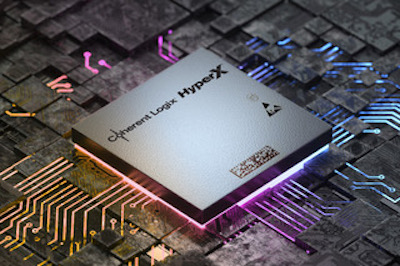How Coherent Logix’s HyperX Processors Are Essential For The Space 2.0 Revolution
By Amit Chowdhry – Jun 1, 2023 – pulse2.com
Coherent Logix is a leader in low-power / high-performance C-programmable processors for the embedded systems market that recently raised $85 million in funding. To learn more about the company, Pulse 2.0 interviewed Coherent Logix co-CEO Walt Gall.

(Walt Gall)
Formation Of Coherent Logix
Coherent Logix was started by Michael Doerr in 2005. In 2002, Doerr was approached by the Defense Advanced Research Projects Agency (DARPA), the agency responsible for driving many key inventions including the Internet. DARPA had requirements for a low-power and high-performance computing asset that could not be met by the major industry players.
Doerr took inspiration from the human brain and designed a chip that used very little energy while quiescent and optimized its use of resources (processor utilization at under 95%) and minimized energy usage in proportion to the workload presented to it. And Doerr solved the challenge presented by DARPA and also created the first HyperX processor design.
How did the idea behind Coherent Logix come together? The corporate structure of Coherent Logix had taken form after it became clear that there were many applications for the HyperX processor. And the company spent between 2005 and 2015 working on projects for major government contractors. In 2009, Coherent Logix sent its first processor to space on the Space Shuttle Atlantis, which delivered the HyperX chip to the International Space Station where it has run successfully since.
Challenges Faced Building The Company
What are some of the challenges that the team faced in building Coherent Logix?
“It’s challenging to move from servicing chiefly Mil-Aero customers to dealing with broader commercial applications here on Earth. We’ve been very fortunate that the attributes HyperX brought to the original ‘edge computing frontier in space’: high performance, low power, small size, and reasonable cost, are now in great demand as computing at the edge takes hold in the terrestrial markets,” said Gall.
Core Products

What are some of Coherent Logix’s core products? The company offers both powerful Systems on Chips (SoCs) and a software suite for creating solutions on them. And the current flagship is HyperX Midnight, a radiation-hardened supercomputer class SoC that is designed for use in LEO, MEO, and GEO (low-, middle-, and geosynchronous earth orbit) satellites.
HyperX Midnight was released in February and immediately became the most advanced space processor available with roughly 4 times the computing throughput at half the power demand of competitive chips.
“This is a very big deal, as performance and power consumption dictate the size of a satellite. Since we put an incredible performance in a small package with low power requirements, our customers can use much smaller satellite busses (chassis) which saves millions in launch costs,” Gall added. “Another key feature of Coherent Logix compared to its competitors are that its chips are C-programmable and use familiar tools and debugging processes. And the solutions can be built on their chip in about 6 months whereas competitive FPGA offerings usually require 24 months of development time using arcane development languages and a very difficult process called timing closure.”
Plus Coherent Logix’s SoCs are also fully reprogrammable, even in space, and can change tasks in less than 50ns (nanoseconds). These 2 features combine to create a huge advantage: Coherent Logix’s customers can create 4 products in the time their competitors take to build just one, and they can continuously improve those products even if they are in orbit around the Earth.
All of these attributes trace back to Coherent Logix’s patented invention: the HyperX fabric. And this fabric is common to all of Coherent Logix’s chips – both Space-qualified and terrestrial – so these same advantages are available whether you are building a satellite, 5G cellular, secure networks, AI analysis platforms, or 8K video encoders.
Evolution Of Technology
When I asked Gall about how the company has evolved, he noted that the company is in its fourth generation of HyperX processors now with over 300 patents granted and more than 150 pending, but the core invention has held up well and its advantages have only grown.
Plus a hot topic in the industry is what is known as Moore’s Wall. While many of us know Moore’s Law: the idea that processing power doubles every two years or so (coined by Gordon Moore at Intel quite a few decades ago). Historically this has been achieved by making smaller and smaller ‘gates’ (the transistors on a chip that contain and execute logic) and putting more of them on a chip, but now those gates are just a few atoms wide. Gall pointed out that the company has largely reached the end of that and it has gotten very expensive to create faster chips. But that has not happened to HyperX yet.
“Our fabric approach is extremely efficient, especially for streaming data, and we haven’t needed the process size reductions others have to go faster. Moore’s wall might get us one day, but it will be long after traditional chip designs run out of steam,” Gall explained.
Biggest Milestones
What were some of Coherent Logix’s biggest milestones? Gall told me that going to space was a big deal for the company and really set them up beautifully to serve the Space 2.0 revolution.
“More recently our expansion from being a Mil-Aero market focused to the broad commercial application of our technology has been an invigorating challenge,” Gall reflected. “The world needs high-performance, low-power computing desperately – our appetite for devices and technology is unrelenting, but we can’t have all those devices making our planet any hotter than it already is, so we have the opportunity to make a real difference in the world and that feels really good.
Funding/Revenue
As mentioned earlier, the company raised $85 million in funding. Atlas Partners provided the funding which will be used for the disruption of the commercial edge, device, communications, and AI markets.
In terms of revenue, Coherent Logix has four revenue sources: semiconductor sales, software ARR, services, and IP licensing. Semiconductor sales and software scale rapidly and both are high-margin businesses for the company. Given that Coherent Logix covers some of the highest growth segments of the market, the company sees something on the order of $280 million in revenue across all segments in 2027 with about 15% to 20% of that coming from software.
Total Addressable Market
What is the total addressable market that Coherent Logix is pursuing? Gall pointed out that across AI/Vision, media, 5G small cell, military/aerospace, and the home Internet of Things (IoT), the total addressable market is about $151 billion. But more realistically, the company competes in subsets of those markets so the serviceable available market (SAM) is more like $32 billion.
Differentiation From The Competition
What differentiates Coherent Logix from the competition? Gall said that there were four main components: High-performance, low power, small size, and reasonable cost. These four things are rarely found together. These four are designed for space, communications, media, connected devices, and data centers.
Future Company Goals
What are some of Coherent Logix’s future company goals? “We’d like to make a real difference in the world – particularly at the edge. Gartner is forecasting there to be 29.4 billion devices on our planet in 2030. And 16.3 billion of those will be net new and many of those will be always on. Our hope is that even as the number of devices more than doubles, we can hold the line or even reduce the total heat load created by devices,” Gall concluded. “We started our business working on the hardest edge of all: Space. We are looking forward to bringing those innovations back down to Earth and making a big difference with them here.”
pulse2.com/coherent-logix-walt-gall-profile/
